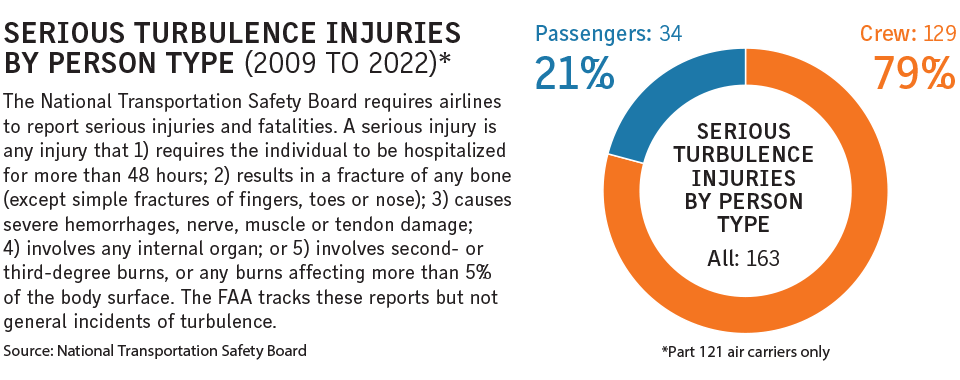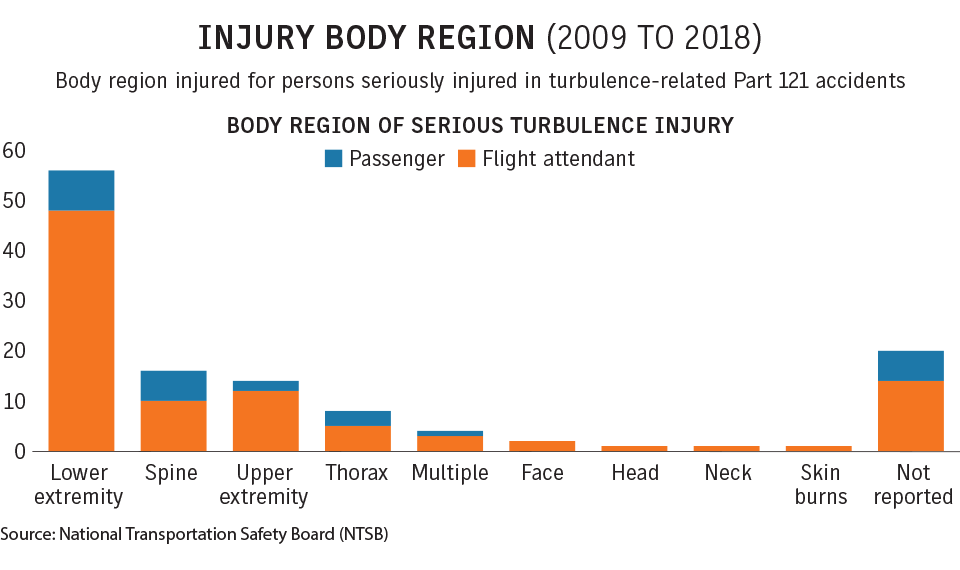Airplane passengers, crew exposed to injury as changing weather increases turbulence
Reprints
Climate change is increasing the likelihood of aircraft turbulence and related injuries to passengers and crew, potentially triggering more litigation against commercial airlines and other aviation entities.
Advances in technology can help mitigate the risks, but human behavior also plays an important role in preventing turbulence-related injuries during flights, experts say.
The incidence of reported events of either major or much rarer severe turbulence is increasing and a result of the changing climate, said Jonathan Ziss, Philadelphia-based partner at Goldberg Segalla LLP.
While statistically air travel is considered “inherently safe, any increase is worth noting and is worth thinking about,” he said.
From 2009 to 2022, the National Transportation Safety Board recorded 163 serious injuries to airline crew and passengers from turbulence on Part 121 air carriers, which includes large and regional airlines and cargo carriers. Injuries to crew accounted for 79%.
The cost of turbulence to U.S. airlines due to injuries — medical attention, missed work and liability payouts — aircraft damage and flight delays is estimated at up to $500 million annually, according to the National Center for Atmospheric Research.
In March, a Lufthansa flight en route from Austin, Texas, to Frankfurt, Germany, was diverted after it encountered significant turbulence at 37,000 feet and seven passengers were injured.
Hawaiian Airlines is facing litigation after severe turbulence on a flight that was 40 minutes from landing in Honolulu last December left 25 passengers and crew injured, six seriously. There were no pilot reports of severe turbulence along the route prior to the accident, but the U.S. National Weather Service had warned of thunderstorms in the area, according to the NTSB’s preliminary report.
While turbulence can occur when the air is disturbed by convective activity, such as thunderstorms, or in the wake of large aircraft, so-called clear-air turbulence is air movement created by jet streams.
CLICK IMAGE TO ENLARGE

Clear-air turbulence has a significant effect on the aviation sector and is increasing with climate change as wind shear strengthens, said Paul D. Williams, a professor of atmospheric science at the University of Reading in England.
“The amount of wind shear in the jet stream has gone up by 15% since satellites began observing it in the 1970s, and that’s because of climate change. Wind shear is what generates turbulence,” Mr. Williams said, noting that the amount of severe turbulence could double or triple by 2050, based on this trend.
For commercial airliners with typical cruising altitudes of 30,000 feet to 42,000 feet, clear-air turbulence is a concern because it’s invisible and increasing at multiple altitudes. “Changing altitudes is not going to be an escape route from this problem,” Mr. Williams said.
Turbulence incidents can be a basis for liability losses, said Marc S. Moller, of counsel at plaintiff law firm Kreindler & Kreindler LLP in New York.
When turbulence causes injuries to passengers on international flights, the Montreal Convention of 1999 applies, basically rendering airlines absolutely liable, Mr. Moller said. In domestic U.S. turbulence incidents, however, passengers have to prove some measure of negligence by the airline, he said.
“Obviously, the pilot gets on the public address system early on and several times during the flight, telling people that they should keep their seat belts buckled because of clear-air turbulence concerns,” he said. But as a flight goes on without a turbulence encounter, warnings may be disregarded by passengers, he said.
CLICK IMAGE TO ENLARGE

Airlines are held to the highest degree of care with regard to safety, so it’s more than just a common negligence standard that would apply, said Mark McKinnon, Washington-based partner at Fox Rothschild LLP.
If an aircraft encounters clear-air turbulence that is undetectable and the pilots had no way of knowing it would occur, however, they’re not “guarantors of the safety of the crew,” Mr. McKinnon said. “If there was no possible negligence, because there was no way for them to detect the turbulence, then there’s not going to be liability,” he said.
Human factors influence the turbulence injury incidence rate, said Daniel Bannister, London-based lead on weather and climate research with the WTW Research Network, part of Willis Towers Watson PLC. “If your seat belt is buckled, then incidents are very low.”
Flight attendants tend to be more at risk to turbulence-related injuries, especially during cruise phases of flights when they are walking through the cabin, doing their job, he said.
At a Federal Aviation Administration safety summit in March, NTSB Chair Jennifer Homendy stated that turbulence accounted for three of every four flight attendant injuries.
Airline crew injured on the job would have a workers compensation claim in the first instance, Mr. Ziss said.
If the injury were sufficiently severe and it was thought that a third-party was to blame — as in bad information from air traffic control, a defective radar system or poor aircraft design — they could also pursue a claim against other entities, he said.
Read Next
-

Technology advances improve turbulence prediction rates
Advances in data and technology are helping airlines reduce injury risks by more accurately measuring turbulence.